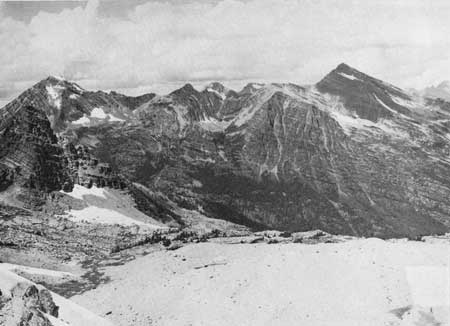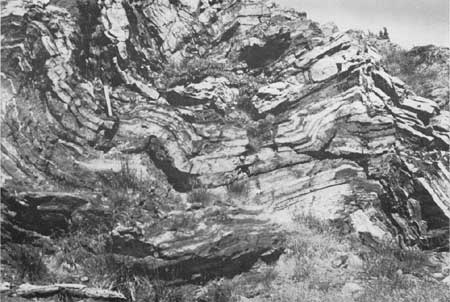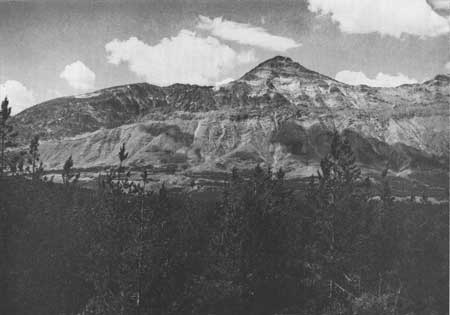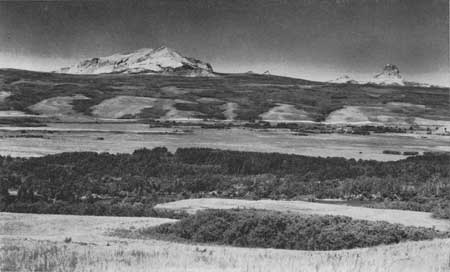
|
Geological Survey Professional Paper 294—K
The Rocks and Fossils of Glacier National Park: The Story of Their Origin and History |
THE LEWIS OVERTHRUST
The broad uplift, possibly with some folding, that had begun earlier continued during the first few million years of the Tertiary period, presumably at an increasing rate. Stream flow was accelerated. As a result, large valleys were cut and the sedimentary rocks that covered the region began to be swept away. The younger, upper beds must have been so soft that they yielded readily to erosion. Large parts of them were removed, exposing older rocks to attack by water and wind, heat and cold.
Some geologists have supposed that erosion by stream flow and associated processes reduced the whole country to a nearly level surface before violent deformation took place. More likely the crustal disturbances were marked enough so that active erosion continued. At the time the major upheaval began, the site of the present Rocky Mountains in this region might well have been hilly, or mountainous, although the topography was by no means as rugged as that of the present day.
The broad uplift and accompanying minor folding of very early Tertiary time gradually merged into more intensive folding. Pressures mounted until they could not be relieved merely by regional warping, and eventually the weaker rocks crumpled into folds. At a fairly early stage, at about the middle of the Paleocene epoch, conditions were like those shown in plate 53B. At this time, as the diagram shows, parts of the younger sedimentary rocks had been eroded away. The effects of the crustal deformation extended to the surface of the ground and were reflected in the topography.
Later the folds were still further compressed and came to resemble those shown beneath the Lewis overthrust in plate 53B and C. Most folds are cracked on or near their crests, and in many places the cracks have grown into overthrusts. Most of these thrusts are small. In the vicinity of Glacier National Park none appear to approach the Lewis itself in magnitude, but farther northwest and southeast some may do so. Much of the folding and part of the fracturing was well advanced before the major fracture that developed into the Lewis overthrust originated. As the Lewis overthrust grew, the folds and fractures continued to yield to mounting pressures. The intricate crumpling and crushing in the immediate vicinity of the main overthrust, visible in localities like that near Marias Pass, shown in figure 139, must have taken place when the heavy overthrust slab was forced over the soft rocks beneath.
Folds that originated at the time represented by plate 53B but that have been accentuated and locally broken by the effects of later pressures, are visible in ridges, cliffs, and canyon walls both in the mountains south of Glacier National Park and in the part of the Great Plains within some 20 miles of the mountain edge at the eastern border of the park. All the sedimentary rocks that were present were squeezed and folded, but the Belt series, being strong and buried under a blanket of other rocks, was deformed the least. Most visitors, especially those who stay on the roads, get the impression that the Belt strata are undisturbed and lie almost as flat today as they did when deposited in the sea that vanished so many million years ago. Actually they are folded, and in certain zones they are intensely so. From points on and near the trails in the park it is possible to observe places where the beds of the Belt series, as revealed in outcrops on ridges, cliffs, and canyon walls, are folded and crumpled almost as intricately as the soft younger strata in the mountains south of the park and in the Great Plains adjoining the park to the east.
One example of crumpled Belt rocks is shown in figure 137. The mountains in this view are not far north of Lake McDonald and the highway, but steep trail climbing is necessary to bring one to points from which the folds are visible. Figure 138 shows a close view of an outcrop of crumpled Belt strata (Grinnell argillite) along the rarely used trail over Two Medicine Pass.

|
| FIGURE 137.—Folded rocks of the Belt series on McPartland Mountain, as seen from the trail to Sperry Glacier. This is one of several zones of relatively intense crumpling in the hard rocks of the park. The photograph has been retouched slightly to emphasize structure. |

|
| FIGURE 138.—Contorted quartzite in the Grinnell argillite, Two Medicine Pass. The light bands represent layers of tough quartzite that were bent and contorted during the disturbance that produced the Lewis overthrust. |
As a result of the folding, the strata were crowded laterally into less space than they had occupied before, which to some extent relieved the accumulated crustal stresses. Compression continued, however, and eventually the strata broke. The great fault known as the Lewis overthrust developed. The beginning of overthrusting initiated the climactic stage in mountain building.
The fracturing that gave rise to the Lewis overthrust began several miles below the surface and probably a long way west of the site of Glacier National Park, where the hard but brittle Belt rocks broke. A slab of tremendous dimensions began to move towards the plains region. As the process went on, this slab extended far northwestward into Canada in one direction and southeastward into southern Montana in the other, a distance of at least 350 miles. The fault surface beneath the displaced slab of rock sloped southwestward. Once the fracture had occurred the pressure that had caused it forced the displaced slab to travel eastward. In some places only a single fault surface formed, with crushed and crumpled soft rocks beneath it. Such a place appears in the cliffs north of Marias Pass, as shown in figure 139. More commonly, numerous faults formed, the larger of which were roughly parallel to each other.

|
| FIGURE 139.—Lewis overthrust on Summit Mountain, as seen from Marias Pass. The dark rock on the upper half of the mountain is of Precambrian age. The lower, lighter colored rock is of Cretaceous age. Note the extreme amount of folding in the Cretaceous rocks under the Lewis overthrust. |
Rocks between these faults were crumpled and crushed in a variety of ways. In some places the zone in which fracturing occurred was as much as 2,000 feet thick; generally it must have been at least several hundred feet thick. Plate 53C shows the situation believed to have existed after overthrusting reached the site of Glacier National Park.
Millions of years probably elapsed between the time when the overthrusting began and the time when it completely ceased. During this long interval, the overthrust slab must have moved very slowly and with frequent pauses. Though the total displacement eventually amounted to many miles, some of the individual movements might have gained only a few inches before cumulative resistance forced a halt. The applications of pressure were intermittent, and tremendous friction had to be overcome in order to move the enormously heavy rock mass above the thrust zone. The magnitude of these physical factors—the pressures and the resistance those pressures had to overcome—is far too vast to comprehend or to express in terms of the ordinary units of measurement.
The fracture zone that constitutes the Lewis overthrust was inclined upward in an east and northeast direction toward the surface, as indicated in plate 53C. If it had reached the surface, the forward end of the moving slab of rock above the fracture zone would have been abruptly freed from the resistances that had retarded its progress underground. Motion for a time might have been rapid, comparable with the motion which takes place at the broken ends of a slab of concrete that fails in a testing machine. The eastern end of the overthrust block might have rushed forward tumultuously. If such a thing had occurred, the rock at the eastern end of the moving mass, freed from the confinement from all sides that had formerly held it together, would have broken up; as it advanced over the surface of the ground the edge would have become a great pile of rubble. Masses of broken rock assigned such an origin have been found in front of overthrusts in other regions. The absence of rubble or breccia is among the compelling reasons that have forced the abandonment of the long-held idea that the Lewis overthrust emerged at the surface and moved over a plain near the front of the present mountains. Those who held that idea assumed that the ground surface was then level enough so that the overthrust slab could move over it readily. They also thought that the relatively flat surfaces that cap ridges east of the park are remnants of the nearly level topography over which the Lewis overthrust moved after it had reached the surface of the ground.
If the advancing slab of rock had been pushed out into the air, the confining pressures that held it together would have tended to be dissipated. Such a slab moving over ground as irregular as is now believed to have existed should have scarred and broken the hills and have itself been broken to a greater or less extent, depending on local conditions. No evidence of either of these things has been found. Further, the flat uplands are regarded now as remnants of a surface much younger than, and not directly related to, the overthrust. The development of this younger surface, called the Blackfoot surface, was guided, to some extent, by the differences in resistance in the rocks above and below the overthrust. The partial correspondence in position between the thrust surface and the remnants of an erosion surface that developed later results from this guidance.
We know little about how major faults like the Lewis overthrust come to an end. Somewhere and somehow each must do so. In the vicinity of the park, the rocks above and below the thrust zone are so completely different from each other that an end to the discordance is difficult to visualize. One possibility is that at a distance of many miles to the east the fracturing gradually decreased and the thrust zone finally feathered out in a few minor cracks without reaching the surface at all. Another possibility is that the thrust zone did reach the surface but so far east of the present mountain front that all evidence of it has been eroded away long since. To the northwest and southeast the thrust zone extends far beyond the limits of Glacier National Park into regions whose geology is incompletely known. Probably in both these directions the thrust zone passes into groups of minor fractures and into folds.
The total amount of displacement on the Lewis overthrust—that is, the distance the rock slab was moved eastward—is a matter of great interest. It has been stated commonly that the displacement amounts to at least 15 miles. This figure is based on the fact that the most easterly exposure of the overthrust, along the mountain front, is about 15 miles east of the exposure in the vicinity of Marias Pass, measured at right angles to the general trend of the overthrust. Certainly the displacement is at least this great, but it could be much greater. East of the mountain front the Cretaceous strata underlying the Great Plains are conspicuously deformed throughout a belt extending 20 miles and more from the most easterly exposure of the overthrust. The deformation in these rocks resulted from the forces that culminated in the overthrust. It is reasonable to suppose that the overthrust slab once extended over most or all of the disturbed zone. Hence one should add 20 miles, locally more, to the figure of 15 miles previously mentioned, and 35 or 40 miles would then represent the minimum amount of displacement. As the Lewis overthrust disappears from view westward under the mountains and is not known to reappear anywhere, the total amount of displacement cannot be determined. It may be much greater than 35 miles. Plate 53D shows the situation today. This diagram, like the others in the sequence, corresponds only to the central part of Glacier National Park. If one inspects the diagram and visualizes the Lewis overthrust extended in both directions from the small segment of it shown, it is easy to see that the actual displacement may be very large.
The trace of the Lewis overthrust zigzags back and forth along the eastern border of the park. Exposures on the sides of the embayments and prominences of the mountain front enable one to observe some of the characteristics of the thrust zone. In most places near the eastern border the thrust is inclined at such low angles that it looks flat. The dip varies, but it averages less than 10° However, both south of Marias Pass and north of the international boundary the thrust zone is much more steeply inclined, probably at 45° and more, One cannot be sure whether the variations in dip are original or the result of disturbances later than the thrusting. It seems likely that most of the irregularities were produced while the overthrusting was in progress. The thrust zone far north and south of the park displays other irregularities. The fault surfaces branch and are locally interrupted. Probably if one could follow the zone continuously north or south he would finally reach a point where the fractures either feather out or merge into folds. At such a point the amount of displacement would be small, even though at intermediate points it was large. Where the thrust zone is steeply inclined, it promptly attains such depths that all its influence on topographic forms is lost. Where, as near the eastern border of the park, the zone is comparatively flat, it exerts greater influence on the topography. This is one of the reasons for the scenic splendors for which Glacier National Park is famous.
Sharp contrasts in rock character that are so well displayed in the park gave rise to the term "rootless mountains," which is often applied to the mountains. The significance of this term is especially obvious with regard to the mountains along the eastern border and outlying summits, such as Chief Mountain (figs. 140 and 141), where the pedestal on which the mountain rests is composed of shale of Cretaceous age, but the mountain itself is carved from the more resistant beds of the Belt series. The fracture zone of the Lewis overthrust lies between the two and the result is a marked zone of weakness on the lower mountain slopes.

|
| FIGURE 140.—Chief Mountain from the northeast, as seen from the East Fork of Lee Creek. (Photograph by Eugene Stebinger.) |

|
| FIGURE 141.—View west across St. Mary River valley toward Yellow Mountain and Chief Mountain, showing the very irregular eastern margin of the Lewis Range. (Photograph by H. E. Malde.) |
Erosion has sapped or undermined the Belt rocks, and this process has developed the exceptionally steep, bold mountain slopes facing the Great Plains. It has aided greatly in the relatively rapid retreat of the mountain front that has laid bare so much of the disturbed zone originally overlain by the slab above the overthrust. Where mountain streams have cut through the fracture zone into the soft rock (largely shale) below, the front of the Lewis Range has been embayed. If streams had been able to cut deep enough into the central part of the Lewis Range or into the Livingstone Range to the west, the mountains there would have been shown to be similarly "rootless"; that is, the rock encountered beneath the overthrust would have been strikingly different from that from which the present mountains are carved. It would have been as different in different localities as the rock now exposed in the mountains south of the park. The diversity in character and age of the rocks in those mountains is shown in appendix A.
The process of overthrusting caused hard, massive Belt rocks to be pushed against and over soft ones, so that the latter were compressed anew and probably also shoved deeper into the earth. As a result, the height attained by the top of the overthrust slab might not have been spectacularly great. If all the rocks had been so resistant that they were essentially incompressible, the slab that was shoved forward during the thrusting would have moved some miles upward into the air. But there are reasons for believing that this did not happen. One reason is that the upper surface of the slab would have been attacked by erosion as soon as uplift started. As the overthrust movement was show and erosion in the uplifted region was vigorous, much of the upper surface of the advancing slab was worn away before it had had a chance to attain really great heights. The fact that the rocks beneath the overthrust were shoved downward during the disturbance also had great influence in limiting the height attained by the surface of the ground.
Differences in the assumed position of sea level with relation to the ground surface in the block diagrams in plate 53 are intended merely to give aim idea of the relief at different stages in the history of the region. The diagrams indicate that the mountain tops were higher above the sea after thrusting than they were before, but not tremendously so. The final diagram, which corresponds to the present day, shows that erosion has been vigorous enough so that the height above sea level is less now than it was at the close of the overthrusting. This is probable even though, on the whole, regional uplift might have been continuous.
Despite the strength of the Belt rocks, it would hardly seem likely that the overthrust slab itself could wholly escape deformation, in view of the great distance it was shoved, the magnitude of the stresses it transmitted, and the enormous frictional resistance it encountered. Attention has already been called to folds locally developed in the overthrust slab during the upheaval. The zone that includes the folds in McPartland Mountain, shown in figure 137, extends from near the Canadian border to the southern part of the park. It is more tightly folded than any other part of the overthrust slab within the park, but the entire slab is flexed into broader folds.
After the major thrusting the slab must have settled, and strains within it tended to be relieved by fracture and faults, accompanied by some folding. The largest of these faults extend northwestward and are in or on the borders of the master valleys in the drainage basin of the Flathead River. A few smaller faults have been detected along valleys roughly at right angles to these. Many of the fractures produced during the settling of the overthrust block produced little displacement in the rocks and many of these might have escaped detection.
Wherever the rocks were broken, streams were able to cut their valleys faster, a fact which has influenced the drainage pattern in the region. In addition, the larger faults of northwesterly trend appear to have allowed slices of the rocks to drop. The depressions thus formed were occupied and enlarged by rivers. In the course of this process the depressions became floored with sediments. That part of the valley of the Flathead River that lies along the western border of Glacier National Park is a conspicuous example. The valley of the Middle Fork of the Flathead is another. In both the principal fault is thought to be a few miles northeast of the present streamway. Movements along faults of this kind continued intermittently for a long time. Perhaps the earthquakes that occasionally are felt in Montana are related to movements of this kind. However, no direct evidence is known of movement as recent as this in the Glacier National Park region.
The two valleys just mentioned and others like them, mostly outside the park, contain a variety of sediments, dumped mainly by active streams from the mountains on either side. In the course of the sedimentation, undrained or nearly undrained hollows were formed in the valley bottoms, giving rise to lakes, ponds, and swamps. Plant remains accumulated in some of these and were eventually converted into coal of varying quality. Some of this coal has been mined for fuel on a small scale, notably at the Coal Banks which is west of the Flathead River and nearly opposite the mouth of Logging Creek.
The oldest of these sediments, now converted into rock, are of Eocene or perhaps early Oligocene age. Sedimentation within the river valleys was intermittent and was interspersed with disturbances that tilted and broke the beds. The forces exerted were trivial in comparison with those related to the Lewis overthrust. Some of the movements may represent nothing more than settling of unstable blocks under the load of later sediments. Most of the tilted sedimentary rocks are of Tertiary age, but some contain fossils that seem to show that they were deposited early in Pleistocene time, less than a million years ago. Slight movements might have occurred even more recently.
These Tertiary and early Pleistocene rocks are for the most part hidden beneath recent stream and glacial deposits, and therefore they are to be observed only in those places where the beds have been freshly exposed, as in stream cuts and manmade excavations. With a little search, one can find good exposures that exhibit tilted and crumpled beds—for example near the North Fork Road between West Glacier (formerly Belton) and the Canadian border, along U.S. Highway 2 between Nyack and Walton, and the bank of the Middle Fork of Flathead River below Double Mountain—visible from U.S. Highway 2.
This chapter has sought to explain how the mountains of Glacier National Park acquired their geologic structure. It has emphasized the fact that mountain building proceeded by stages that were different in character and that unfolded majestically one after the other through millions of years. In terms of geologic chronology, the mountain-building movements began late in Cretaceous time, then gained in intensity, and culminated in the overthrusting during late Paleocene and early Eocene time. Thereafter the movements diminished, but they continued intermittently until relatively recent time.
| <<< Previous | <<< Contents >>> | Next >>> |
pp/294-K/sec4.htm
Last Updated: 08-Jul-2008